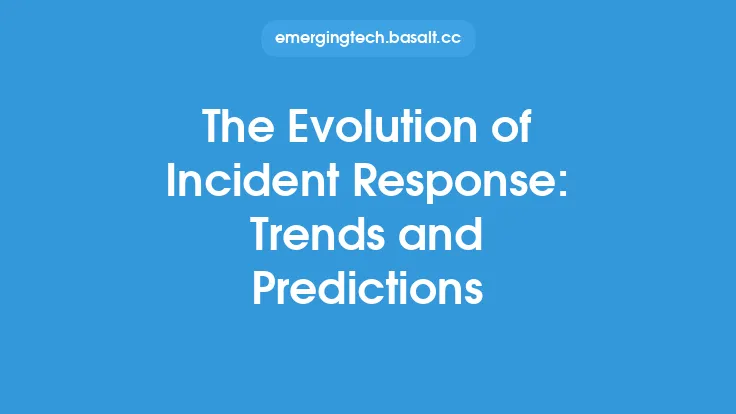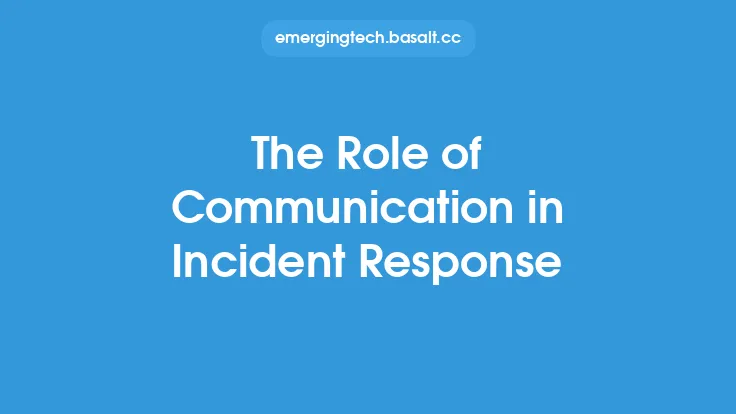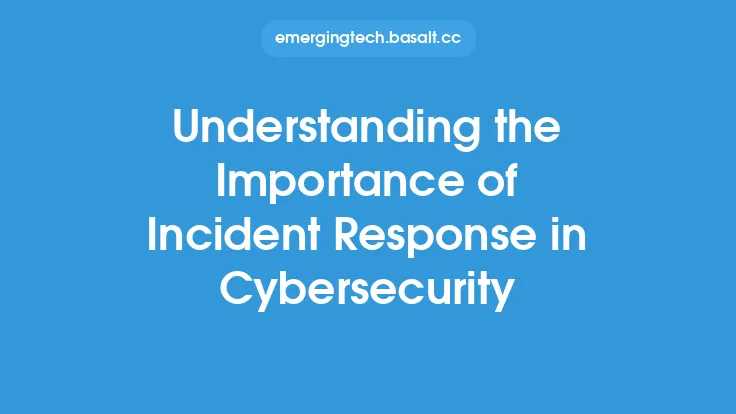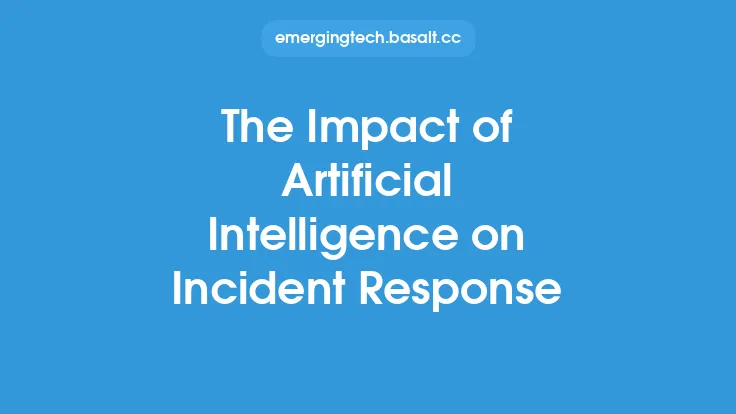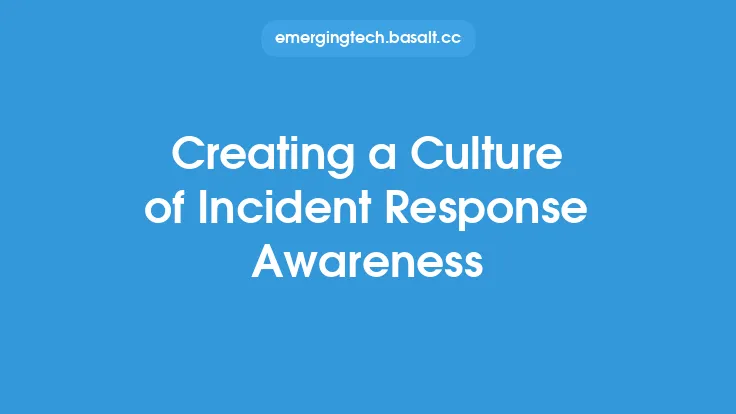Measuring the success of incident response efforts is crucial for organizations to evaluate the effectiveness of their incident response plans, identify areas for improvement, and optimize their response strategies. Incident response is a critical component of cybersecurity, and its success can have a significant impact on an organization's reputation, financial well-being, and overall security posture. In this article, we will delve into the key metrics and indicators that organizations can use to measure the success of their incident response efforts.
Introduction to Incident Response Metrics
Incident response metrics are quantifiable measures that help organizations assess the effectiveness of their incident response plans. These metrics can be categorized into several key areas, including detection, response, containment, eradication, recovery, and post-incident activities. By tracking and analyzing these metrics, organizations can identify trends, patterns, and areas for improvement, ultimately enhancing their incident response capabilities. Some common incident response metrics include mean time to detect (MTTD), mean time to respond (MTTR), mean time to contain (MTTC), and mean time to recover (MTTR).
Key Performance Indicators (KPIs) for Incident Response
Key performance indicators (KPIs) are measurable values that demonstrate how effectively an organization is achieving its incident response objectives. KPIs for incident response can be categorized into several areas, including:
- Detection KPIs: These KPIs measure the effectiveness of an organization's threat detection capabilities, including the number of true positives, false positives, and false negatives.
- Response KPIs: These KPIs measure the speed and effectiveness of an organization's response to incidents, including MTTR, MTTC, and MTTR.
- Containment KPIs: These KPIs measure the effectiveness of an organization's containment strategies, including the time taken to contain an incident and the number of systems or data affected.
- Eradication KPIs: These KPIs measure the effectiveness of an organization's eradication strategies, including the time taken to eradicate the root cause of an incident and the number of incidents recurring over time.
- Recovery KPIs: These KPIs measure the effectiveness of an organization's recovery strategies, including the time taken to recover from an incident and the number of systems or data restored.
Metrics for Evaluating Incident Response Effectiveness
In addition to KPIs, organizations can use several other metrics to evaluate the effectiveness of their incident response efforts. These metrics include:
- Incident frequency and severity: This metric measures the number and severity of incidents over time, helping organizations identify trends and patterns in their incident response data.
- Incident response cost: This metric measures the financial cost of incident response efforts, including the cost of personnel, equipment, and other resources.
- Downtime and data loss: This metric measures the impact of incidents on business operations, including the amount of downtime and data loss incurred.
- Customer satisfaction: This metric measures the satisfaction of customers and stakeholders with an organization's incident response efforts, including the speed and effectiveness of response and communication.
Tools and Techniques for Measuring Incident Response Success
Several tools and techniques can be used to measure the success of incident response efforts, including:
- Incident response platforms: These platforms provide a centralized dashboard for tracking and managing incident response efforts, including metrics and KPIs.
- Security information and event management (SIEM) systems: These systems provide real-time monitoring and analysis of security-related data, helping organizations detect and respond to incidents more effectively.
- Threat intelligence platforms: These platforms provide organizations with real-time threat intelligence, helping them stay ahead of emerging threats and improve their incident response capabilities.
- Post-incident reviews and analysis: These reviews and analysis help organizations identify areas for improvement and optimize their incident response strategies over time.
Best Practices for Measuring Incident Response Success
To measure the success of incident response efforts effectively, organizations should follow several best practices, including:
- Establish clear metrics and KPIs: Organizations should establish clear metrics and KPIs for measuring incident response success, including detection, response, containment, eradication, and recovery metrics.
- Use automated tools and techniques: Organizations should use automated tools and techniques, such as incident response platforms and SIEM systems, to streamline and optimize their incident response efforts.
- Conduct regular post-incident reviews and analysis: Organizations should conduct regular post-incident reviews and analysis to identify areas for improvement and optimize their incident response strategies over time.
- Provide ongoing training and awareness: Organizations should provide ongoing training and awareness programs for incident response teams, helping them stay up-to-date with the latest threats, trends, and best practices.
Challenges and Limitations of Measuring Incident Response Success
Measuring the success of incident response efforts can be challenging, and several limitations and challenges should be considered, including:
- Data quality and accuracy: Incident response metrics and KPIs are only as good as the data they are based on, and organizations should ensure that their data is accurate, complete, and reliable.
- Complexity and variability: Incident response efforts can be complex and variable, making it challenging to establish clear metrics and KPIs that apply to all incidents.
- Resource constraints: Measuring incident response success can require significant resources, including personnel, equipment, and budget, and organizations should ensure that they have the necessary resources to support their measurement efforts.
- Evolving threats and trends: Incident response efforts must evolve to keep pace with emerging threats and trends, and organizations should ensure that their measurement efforts are flexible and adaptable to changing circumstances.
Conclusion
Measuring the success of incident response efforts is critical for organizations to evaluate the effectiveness of their incident response plans, identify areas for improvement, and optimize their response strategies. By establishing clear metrics and KPIs, using automated tools and techniques, conducting regular post-incident reviews and analysis, and providing ongoing training and awareness, organizations can ensure that their incident response efforts are effective and successful. However, several challenges and limitations should be considered, including data quality and accuracy, complexity and variability, resource constraints, and evolving threats and trends. By understanding these challenges and limitations, organizations can develop effective measurement strategies that help them achieve their incident response objectives and stay ahead of emerging threats.
